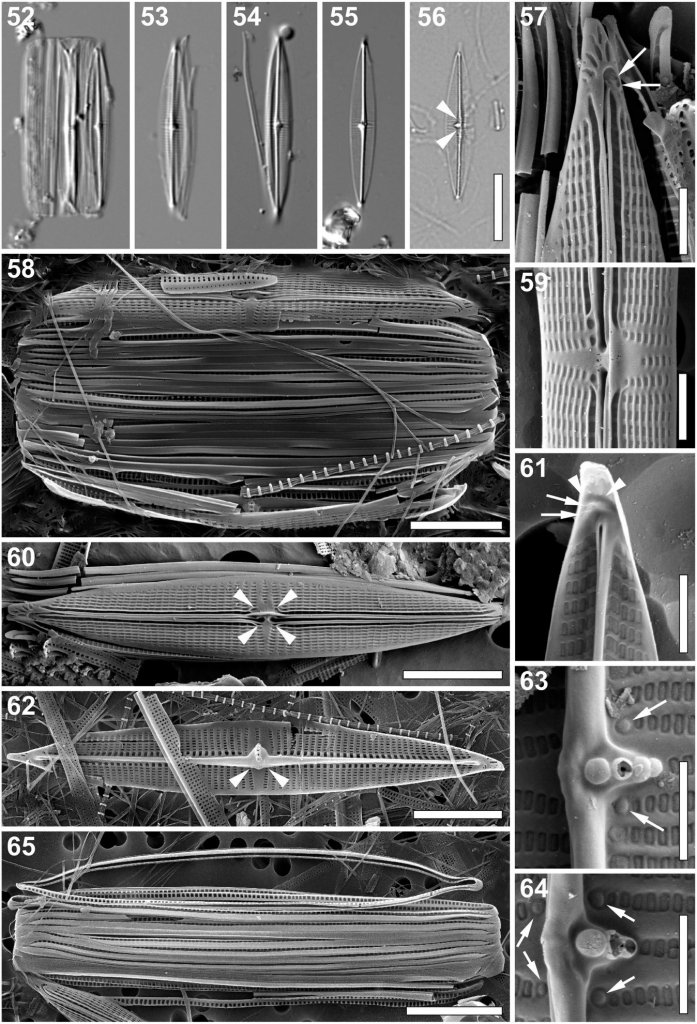Isotype of this species is deposited in the Croatian National Diatom Collection as permanent slide under accession number HRNDC000007.

From the Latin word torquata (‘wearing a necklace’), with reference to the internal fistula occlusion resembling a necklace with 2–5 beads.
Marine Turtle Rescue Centre, Pula, Croatia (44°50′07′′N, 13°49′58′′E). Collected from a semi-adult (45 kg) female loggerhead Caretta caretta named ‘Palma Modesty’ by K. Gobić Medica, 30 September 2016 (holotype). Kosi Bay, South Africa (27°00′29′′S, 32°52′49′′E). Collected from the barnacle Platylepas coriacea growing on the adult female leatherback Dermochelys coriacea (tag numbers: ZATT559, ZAST653) by C. Nolte, 8 January 2016 (paratype).
Light microscopy (Figs 52–56):
Frustules in girdle view rectangular with broadly rounded ends and numerous copulae (Fig. 52). Valves narrowly lanceolate with slightly protracted, cuneately rounded apices (Figs 53–56). Valve dimensions (n = 25): length 21–32 μm, width 3–5 μm, length/width ratio 5.6–7.9. Axial area narrow, distinct raphe-sternum present (Figs 52–56). Striae very fine, barely discernible, 28–32 in 10 μm, sparser, slightly convergent and clearly visible near the central area (Figs 52–56). Fistula transapically elongated (Figs 52–56). Central raphe endings evident on one side of the raphesternum (Fig. 56, arrowheads). Helictoglossae at the apices visible as refractive dots (Figs 55, 56). Girdle bands open, appearing unornamented (Figs 52–54).
Scanning electron microscopy (Figs 57–65):
External view: Valve face flat with slightly raised longitudinal silica strips interrupted at the central area running between the areolae, flattening near the valve margins (Figs 57–60). Mantle very shallow (Figs 58, 60). Clear pore-free zone running around the entire valve at the valve face/mantle junction (Figs 57–60). Striae uniseriate, parallel, becoming slightly convergent close to the apices and near the central area, composed of rectangular, apically elongated areolae (Figs 57–60). Areolae near the axial area larger, clearly sunken and partially covered by a narrow, heavily silicified conopeum with a single central groove (Figs 57–60). Areolae near the valve margin becoming smaller, getting an irregular shape (Figs 57, 58, 60). Raphe branches straight, partially obscured by the thickened rims of the conopeum (Figs 57–60). Central raphe endings elongated, slightly expanded, with a distinct silica rim, slightly deflected towards the fistula (Figs 59, 60). Terminal raphe fissures strongly hooked towards secondary side of the valve (Figs 57, 58, 60). Two or three irregular hymenate areolae embedded within hooks of the terminal raphe fissures (Figs 57, 58, arrows). Central area asymmetrical, V-shaped, with a single shortened stria on the primary side of the valve and a triangular pore-free area created by two convergent striae on the opposite side of the raphe (Fig. 59, 60). A pocket-like rimmed silica flap completely obscuring the fistula opening on the primary side of the valve (Figs 59, 60). Four roundish pores adjacent to the striae bordering the central area present, partially hidden under the silica rims extending from conopeum and the central longitudinal strips (Fig. 60, arrowheads). Apices with several elongated, irregular areolae close to the valve margins poleward of the terminal fissures (Figs 57, 58, 60).
Internal view: Striae almost parallel extending from the pore-free mantle to the prominent raphesternum, composed of narrowly rectangular and apically elongated areolae (Figs 61–64). Areolae close to the raphe-sternum transapically elongated, much larger and raised (Figs 61–63). Raphe slit visible only at the apices, opening laterally on the raphe-sternum (Figs 61, 62). Central raphe endings covered by an elongated and somewhat flattened thickening of the central nodule extending laterally from the axial rib to the secondary side of the valve (Figs 62, arrowheads, 63, 64). Fistula located on lateral expansion of the central nodule showing a complex structure with a series of 2–5 circular openings occluded by finely perforated domed hymenes (Figs 62–64). Occlusions of the four pores adjacent to the central striae clearly rounded and domed (Figs 62, 63 arrows, 64 arrows). Terminal raphe endings slightly expanded, lying somewhat laterally on the sternum, terminating onto simple helictoglossae (Figs 61, 62). Thickenings corresponding to the external raphe fissures present poleward from helictoglossae (Figs 61, arrowheads, 62). Two or three areolae at the end of the hooked thickenings (Fig. 61, arrows) and those at the apices (Fig. 61) occluded by weakly raised hymenes. Cingulum consisting of multiple open copulae (Figs 57, 58, 60, 65), folded with the fold on the cell interior (Figs 58, 65). Pars interior with row of hymenate, rectangular, transapically elongated pores (Figs 57, 58, 60, 65), pore density ca. 5 in 1 μm. Pars exterior plain (Figs 57, 58, 60, 65).